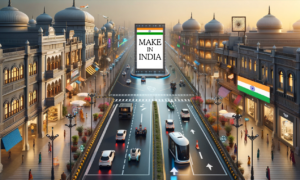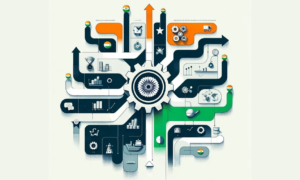‘Make in India’, an emblematic program inaugurated by the Government of India in 2014, is ambitiously designed to metamorphose the nation into a pivotal hub of global manufacturing. This blog delves deeply into the nuances of this initiative, meticulously examining its goals, focal sectors, notable triumphs, and the hurdles it faces. Furthermore, it elucidates the profound and multifaceted impact this initiative has had on both the Indian economy and the international market landscape. This comprehensive exploration offers a panoramic view of ‘Make in India’, capturing its essence as a transformative force in the global manufacturing arena.
‘Make in India’ was launched on September 25, 2014, by Prime Minister Narendra Modi. This initiative was a significant move by the Government of India, aimed at reviving the country’s manufacturing sector and positioning India as a global manufacturing hub.
Now let’s begin with…
What are the Objectives of the ‘Make in India’ campaign?

The fundamental aim of the ‘Make in India’ initiative is to inspire both domestic and international corporations to establish their manufacturing bases in India. Its objectives are strategically crafted to:
Elevate Foreign Direct Investment (FDI): This involves drawing in international enterprises to launch and expand their manufacturing facilities in India, thereby boosting the influx of foreign capital.
Augment Job Creation: By invigorating the manufacturing sector, the initiative seeks to generate substantial employment opportunities, thus fueling economic growth and reducing unemployment.
Foster Innovation: ‘Make in India’ strongly emphasizes stimulating innovation across various industries, advocating for modernization and the adoption of cutting-edge technologies.
Fortify Infrastructure: A key focus is also on enhancing India’s industrial infrastructure, thereby positioning the nation as a globally competitive and attractive destination for manufacturing ventures.
What are the key sectors under the ‘Make in India’ campaign?
The ‘Make in India’ initiative targets various key sectors to boost manufacturing and economic growth. These sectors include:
Automotive: The initiative strives to position India as a leader in the automotive sector by encouraging domestic manufacturing and innovation.
Information Technology: ‘Make in India’ promotes the growth of the IT and electronics manufacturing industry, fostering a self-reliant and globally competitive sector.
Textiles: The initiative aims to support India’s rich traditional textile industry while also promoting modern garment manufacturing, contributing to job creation and economic development.
Biotechnology: ‘Make in India’ focuses on the biotechnology sector, emphasizing the manufacturing and research of pharmaceuticals and biotech products.
Aviation and Aerospace: The initiative is geared towards developing the aerospace industry, including defense manufacturing capabilities, to enhance self-sufficiency and global competitiveness.
Renewable Energy: ‘Make in India’ actively promotes the manufacturing of renewable energy equipment, supporting the country’s commitment to sustainable development and clean energy initiatives.
These key sectors play a crucial role in the overall economic development of India by fostering innovation, job creation, and technological advancement. The ‘Make in India initiative encourages both domestic and foreign investment in these sectors to build a robust and self-reliant industrial base in the country.
What have been the achievements of the ‘Make in India’ initiative?
The surge in Foreign Direct Investment: A remarkable uptick in FDI flows into the manufacturing sector marks one of the notable triumphs of the ‘Make in India’ initiative. This influx signifies increased global confidence in India’s manufacturing capabilities.
Enhancement of Manufacturing Growth: The initiative has catalyzed a notable expansion in the manufacturing industry’s contribution to India’s GDP, indicating robust sectoral growth and a positive impact on the overall economy.
Cultivation of Global Partnerships: ‘Make in India’ has been instrumental in forging many strategic alliances between Indian enterprises and their international counterparts, fostering a global network of business collaborations.
What are the challenges and solutions associated with the ‘Make in India’ initiative?
Infrastructure Development: Addressing the existing gaps in infrastructure emerges as a critical factor. By bolstering infrastructural foundations, ‘Make in India’ seeks to allure large-scale manufacturing investments, essential for the sector’s expansion.
Skill Development: Elevating the proficiency and skill set of the Indian workforce is pivotal. The initiative emphasizes aligning India’s labor skills with international manufacturing standards, ensuring a competitive and efficient workforce.
Regulatory Reforms: Streamlining business operations and regulatory frameworks is another focal area. By simplifying these processes, ‘Make in India’ aims to facilitate smoother establishment and functioning of businesses, thus enhancing the ease of doing business in the country.
These achievements and targeted solutions underscore ‘Make in India’s’ strategic approach towards transforming India into a global manufacturing powerhouse, while continuously addressing and overcoming the inherent challenges of this ambitious journey.
‘Make in India’ has significantly impacted the Indian economy by diversifying its economic structure, reducing reliance on traditional sectors, creating numerous job opportunities, and boosting the export potential of Indian goods. On the global stage, the initiative has enhanced India’s manufacturing image, attracted multinational companies to establish a presence, and increased the competitiveness of Indian products internationally. The future outlook for ‘Make in India’ appears promising, supported by continuous government backing, growing global interest, and ongoing improvements in infrastructure and policies, positioning India for economic superpower status.
Summary
In summary, ‘Make in India’ represents a significant effort to rejuvenate India’s manufacturing sector, with the broader aim of fostering economic growth, creating employment opportunities, attracting foreign investment, and establishing India as a powerhouse in the global manufacturing landscape.
‘Make in India’ represents a significant step towards realizing India’s manufacturing potential. By addressing challenges and building on its achievements, the initiative can lead to sustainable economic growth and position India as a global manufacturing leader. This initiative is not just about manufacturing; it’s about transforming the entire economic landscape of India.

